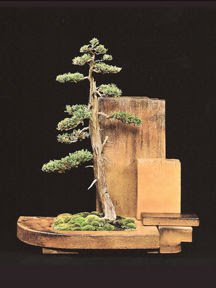Contemporary Movement in Containers
Ron lang’s perspectives
With many artists looking to move away from the traditional pot, I listened intently to Ron’s words and purpose around the importance of the container in American bonsai.
I still try to make containers that are not considered traditional at all. I fall back on my interest in geometry, geology and architecture to get inspiration.
Inspired by: Sarah Rayner, Don Gould and Max Braverman. Nick Lenz. Brett Thomas. Jonathan Cross.
Nick’s wife, Sharon Edwards-Russell, is more spontaneous. She also tends to do a lot of details that I don't; carving, manipulating the surface to look like rock formations and things like that.
Some beginning potters just suffer from a lack of technique and lack of clear proportions. They lack a sense of cohesiveness between the different elements of a pot. Again, what does that foot have to do with the rest of the pot? Does this wall profile work this type of lip? I mean a lot of American potters are self-taught, and they come to it through bonsai, which is a good thing because they understand the container is more than a cereal bowl with holes in the bottom. They understand the necessary proportions, but they haven’t been trained in the basics of ceramics. And that’s OK, its hard to find anyone, including myself, that are well schooled in every element of ceramics.
Michael Hagedorn May be saying, I don’t think of bonsai as a tree and a container. It’s just a tree extracted somehow from nature. I think that sets up an interesting dynamic to talk about, because to me, the container is intrinsic. Bonsai is a tree that's in a container. Whether that container is camouflaged, it still needs to be containerized, for life support, right?
“The magic of bonsai is really the wonder of seeing a living tree, in miniature scale, that’s initiated by the container that’s beneath it. It’s more than a substitute for Mother Earth, it’s an artistic mechanism. It’s the human element that stages the tree, it stages the drama. And I’m using “staged” purposefully. It’s nature and man-made coming together in theater. I think we are celebrating the manmade and the natural when we put a container underneath a tree. You are acknowledging that this tree wasn't lifted out of the ground and just looks like this. The tree has been manipulated, loved. It's been cared for. It's been tweaked, you know, and it has been shaped to a person's feeling bringing out the best in that piece of material. And I think that's what a good container underneath a tree is, it’s a kind of celebration, a kind of staging for that that relationship between the tree and pot.”
—Ron Lang







